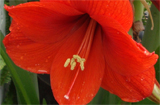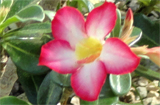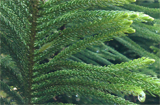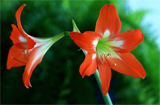Plants for the Holidays
Poinsettias are a common choice for gifts and decorations during the winter, but other options are equally beautiful and sure to please. Surprise people with a new twist on the traditional holiday plant by giving some of these unique varieties.
African Violet
These plants are good for the home environment because they do well in lower light. With its diversity of colors and texture, there is a variety for everyone.
 Make sure the potting soil provides moisture retention and good drainage. Garden centers often have special potting mixes for African violets.
Make sure the potting soil provides moisture retention and good drainage. Garden centers often have special potting mixes for African violets.
African violets prefer indirect light and warmth (70–80ºF). Healthy green leaves and frequent flowering lets you know the plant is doing well. Poor flowering and pale or yellowish-green leaves are signs of improper lighting.
Amaryllis
Amaryllis, which is often found in containers, has lily-like, trumpet-shaped flowers. Bulbs can be bought already sprouted, or you can sprout your own.
 Amaryllis bulbs should be potted between September and January. When potting, place them in a container that allows two inches of space between the bulb and the pot—half of the bulb should be exposed. When you plant it, water it well, but then wait to water again until the bulb begins to sprout.
Amaryllis bulbs should be potted between September and January. When potting, place them in a container that allows two inches of space between the bulb and the pot—half of the bulb should be exposed. When you plant it, water it well, but then wait to water again until the bulb begins to sprout.
Since amaryllis needs sun, place the pot in a warm location with direct sunlight. Once the flowers open, move the plant from direct sun to indirect—but still bright—light. When that plant has finished blooming, move it to light shade and continue to water and feed for new growth.
Desert Rose
Unlike its name, this exotic plant is not a rose—it’s actually a succulent from Africa. It has thick gray-green stems, a swollen base, and tubular flared flowers in red, pink, and white shades.
 Desert roses can be grown in containers because they provide greater control over moisture and temperature. If it is too cold or rainy outside, then bring the plant inside.
Desert roses can be grown in containers because they provide greater control over moisture and temperature. If it is too cold or rainy outside, then bring the plant inside.
Make sure to use a cactus potting mix, and put it in a pot wide enough for the swollen stem. Watch for stem or root rot, which can happen if the plant is kept too moist.
Norfolk Island Pine
This "mini Christmas tree" is an evergreen from the South Pacific. The pyramid-shaped tree has dark green, needle-like leaves.
 While they're small, these pines make good indoor plants and can live a long time with proper care. Place the pots in full sun or a bright indoor space. Don’t overwater, or the plant will drop its lower foliage.
While they're small, these pines make good indoor plants and can live a long time with proper care. Place the pots in full sun or a bright indoor space. Don’t overwater, or the plant will drop its lower foliage.
Plants will have to be repotted every two to three years. Once your pine outgrows normal size pots, you may not want to plant it in your landscape. Be aware these trees can get up to 80 feet tall and are notorious for uprooting in storms.
Rosemary Topiary
This herb makes a good smelling addition to the holiday plant list. You can trim the plant into a shape, such as a "mini tree" similar to the Norfolk Island pine.
 Rosemary flowers in winter and spring, and, if it is left unclipped, it can grow up to five feet tall with a five-foot spread. Trim rosemary plants every few weeks to encourage new growth and to maintain the desired topiary shape.
Rosemary flowers in winter and spring, and, if it is left unclipped, it can grow up to five feet tall with a five-foot spread. Trim rosemary plants every few weeks to encourage new growth and to maintain the desired topiary shape.
If you decide to take your plant out of the pot and put in an herb garden, make sure its planting site is in full sun with well-drained soil.
For more information on caring for house plants, contact your local Extension office.
Adapted and excerpted from:
R. Mitchell, "Some Holiday Plants to Give and Receive" (72KB pdf), UF/IFAS Charlotte County Extension (Accessed 11/2014).

Related Sites & Articles
- Hot Topics
- Green Holiday
- Holiday Plants: What to Do with Plants After the Holidays
- Poinsettias
- UF/IFAS Publications
- African Violet
- Amaryllis
- Norfolk Island Pine
- UF/IFAS Sites
- Alternative Holiday Plants
- Caring for Holiday Gift Plants
- House Plants
- Living Christmas Trees

